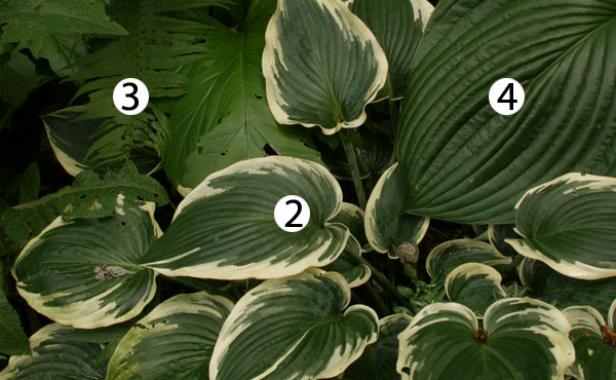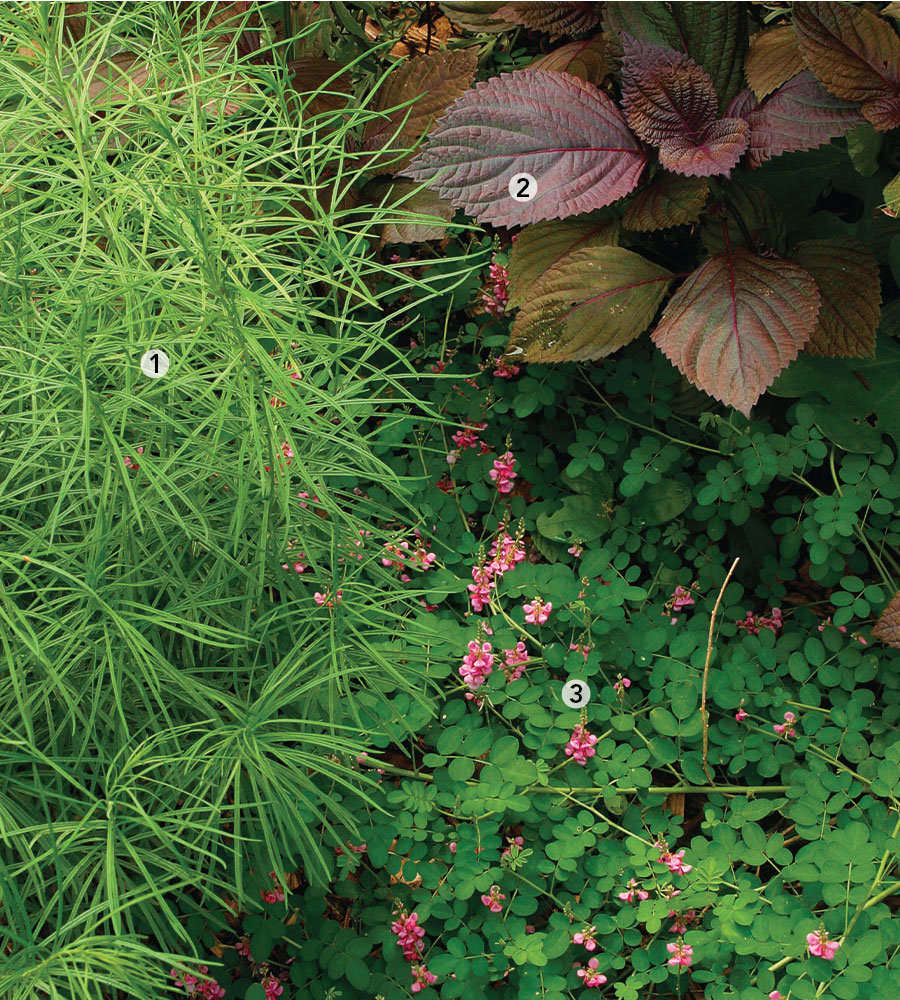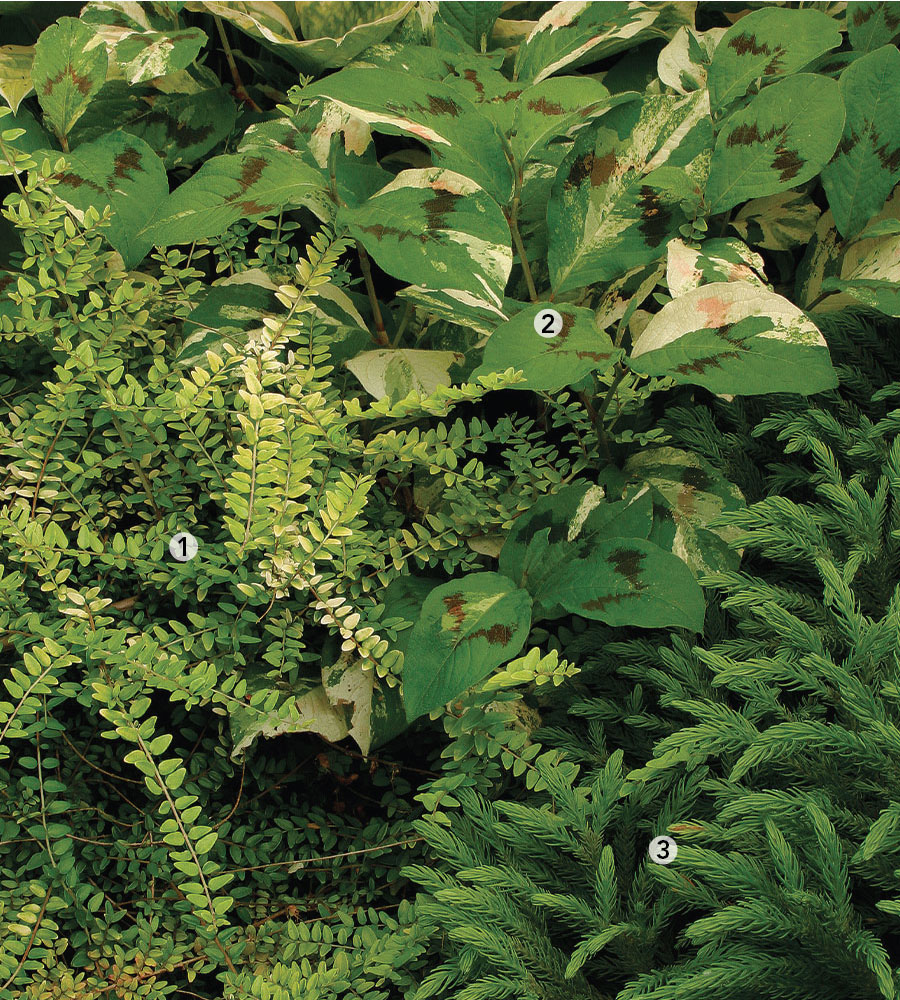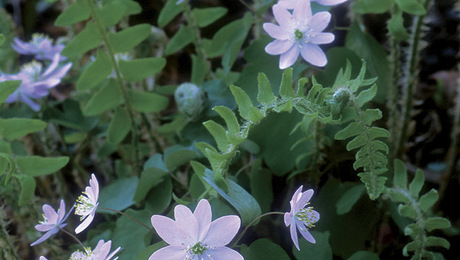
When it comes to gardening, shade is a lot like a rainstorm at a picnic: It isn’t in your ideal plan, but you have to make the best of the situation. Believe it or not, I actually prefer to garden in the shade because it takes more thought and creativity to combine plants successfully. We all know that the key to combinations that work is how we use color, texture, and form. But when it comes to shade, color is the most important factor. Without color, shade gardens would be nothing but a sea of never-ending green. How boring.
I rely on three specific colors to make low-light areas pop: white, gold, and some sort of red hue (crimson, burgundy, deep pink, or orange). I use each of these colors differently and in specific areas of the garden. By following the guidelines I’ve developed, you’ll be able to create stunning shade combinations. So if you believe that only people with sunny gardens can achieve eye-catching plant pairings, think again.
White lightens the deepest shade
Areas of deep shade can be the most problematic spots to infuse life. Under trees or on the north side of a building is usually considered a “no-plant’s land” of the garden, where you’re happy just to have anything grow at all. But these spots are ideal opportunities to site plants with white variegation. Because the plants that live in these black holes of the garden are usually dark green, dashes of white not only offer a nice color contrast but also highlight the form and texture of the surrounding selections.
- ‘Autumn Bride’ heuchera (Heuchera villosa ‘Autumn Bride’, USDA Hardiness Zones 5–9)
- ‘Hadspen Cream’ brunnera (Brunnera macrophylla ‘Hadspen Cream’, Zones 3–7)
- ‘Silver Sceptre’ sedge (Carex ‘Silver Sceptre’, Zones 5–9)
- ‘Silver Tassel’ sedge (Carex morrowii ‘Silver Tassel’, Zones 5–9)
- ‘Milky Way’ epimedium (Epimedium × youngianum ‘Milky Way’, Zones 5–9)
- ‘High Society’ hosta (Hosta ‘High Society’, Zones 3–9)
- Arborvitae fern (Selaginella braunii, Zones 7–11)
- ‘Silver Sceptre’ sedge (Carex ‘Silver Sceptre’, Zones 5–9)
- ‘Great Expectations’ hosta (Hosta ‘Great Expectations’, Zones 3–9)
- Japanese forest grass (Hakonechloa macra, Zones 5–9)

- Korean boxwood (Buxus microphylla var. koreana, Zones 4–9)
- Hosta (Hosta cv., Zones 3–9)
- Christmas fern (Polystichum acrostichoides, Zones 3–8)
- ‘Mister Big’ hosta (Hosta ‘Mister Big’, Zones 3–9)

- ‘Ice Dance’ variegated sedge (Carex morrowii ‘Ice Dance’ , Zones 5–9)
- Hosta (Hosta cv., Zones 3–9)
- ‘Baggesen’s Gold’ boxleaf honeysuckle (Lonicera nitida ‘Baggesen’s Gold’, Zones 6–9)
- ‘Yoshino’ Japanese cedar (Cryptomeria japonica ‘Yoshino’, Zones 6–9)
- Dwarf Alberta spruce (Picea glauca ‘Conica’, Zones 2–6)
- ‘Anceps’ fountain bamboo (Fargesia nitida ‘Anceps’, Zones 5–9)
- ‘Silver Sceptre’ sedge (Carex morrowii ‘Silver Sceptre’, Zones 5–9)
- Japanese tassel fern (Polystichum polyblepharum, Zones 6–8)
- Fastigiate plum yew (Cephalotaxus harringtonia ‘Fastigiata’, Zones 6–9)
Red breaks up the green in light shade
Soft colors don’t usually work in shade because they aren’t dynamic enough to shine in the darkness. Use, instead, plants that have blossoms or foliage with vibrant, hot colors. These hues need more sunlight, so areas of light shade are best. Because of their vibrancy, these colors act like beacons, attracting attention not only to themselves but also to their neighbors. Red and most other hot colors are also opposite to green on the color wheel, so they naturally complement the customary hue of the shade garden.
- Tiger eyes™ cutleaf staghorn sumac (Rhus typhina ‘Bailtiger’, Zones 4–8)
- ‘Shaina’ Japanese maple (Acer palmatum ‘Shaina’, Zones 5–9)
- ‘Gartenmeister Bonstedt’ fuchsia (Fuchsia ‘Gartenmeister Bonstedt’, Zones 9–10)
- ‘Alabama Sunset’ coleus (Solenostemon scutellarioides ‘Alabama Sunset’, Zone 11)
- ‘Pee Dee Ingot’ liriope (Liriope muscari ‘Pee Dee Ingot’, Zones 6–10)
- ‘Filigree Lace’ weeping birch (Betula pendula ‘Filigree Lace’, Zones 2–7)
- Threadleaf bluestar (Amsonia hubrichtii, Zones 5–8)
- Purple perilla (Perilla frutescens ‘Atropurpurea’, annual)
- Chinese indigo (Indigofera decora, Zones 7–9)

- ‘Nikko’ deutzia (Deutzia crenata var. nakaiana ‘Nikko’, Zones 4–8)
- ‘Othello’ ligularia (Ligularia dentata ‘Othello’, Zones 4–8)
- ‘Sagae’ hosta (Hosta ‘Sagae’, Zones 3–9)
- ‘Mt. Fuji’ Japanese iris (Iris ensata ‘Mt. Fuji’, Zones 3–9)
- ‘Spectabile’ knotweed (Polygonum ‘Spectabile’, Zones 5–9)
Gold makes partial shade glow
I use golden (and sometimes chartreuse) plants in medium-shade areas to help enhance the glow of what little sunlight touches the garden. Gold magnifies sunlight, casting a glow onto plants nearby. It’s a bad idea to put gold-variegated plants in deep shade because they like to revert back to all-green. In areas with too much sun (with only light shade), they turn an unsightly electric yellow and burn out. The illuminating quality of gold brings out the rough or puckered texture of plants. So if you have a hosta with deeply ridged leaves, place a golden or chartreuse companion with a smooth texture nearby.
- ‘Baggesen’s Gold’ boxleaf honeysuckle (Lonicera nitida ‘Baggesen’s Gold’, Zones 6–9)
- ‘Painter’s Palette’ knotweed (Persicaria virginiana ‘Painter’s Palette’, Zones 5–9)
- ‘Globosa Nana’ Japanese cedar (Cryptomeria japonica ‘Globosa Nana’, Zones 6–9)
- ‘On Stage’ hosta (Hosta ‘On Stage’, Zones 3–9)
- Purple perilla (Perilla frutescens ‘Atropurpurea’, annual)
- ‘All Gold’ Japanese forest grass (Hakonechloa macra ‘All Gold’, Zones 5–9)
- ‘Painter’s Palette’ knotweed (Persicaria virginiana ‘Painter’s Palette’, Zones 5–9)
- ‘Hi Ho Silver’ hosta (Hosta ‘Hi Ho Silver’, Zones 3–9)
Inta Krombolz gardens deep in the woods of West Chester, Pennsylvania, and likes to create welded garden statuary in her spare time.
Photos: Danielle Sherry




























Comments
There's kind of a lot of errors on this page. Can someone review it? I would like to actually know what some of these plants are and they are not labeled in every pic. Thanks.
Seconding the errors on this. The listing of plants is not tied to the correct images. Someone definitely needs to review.
Log in or create an account to post a comment.
Sign up Log in